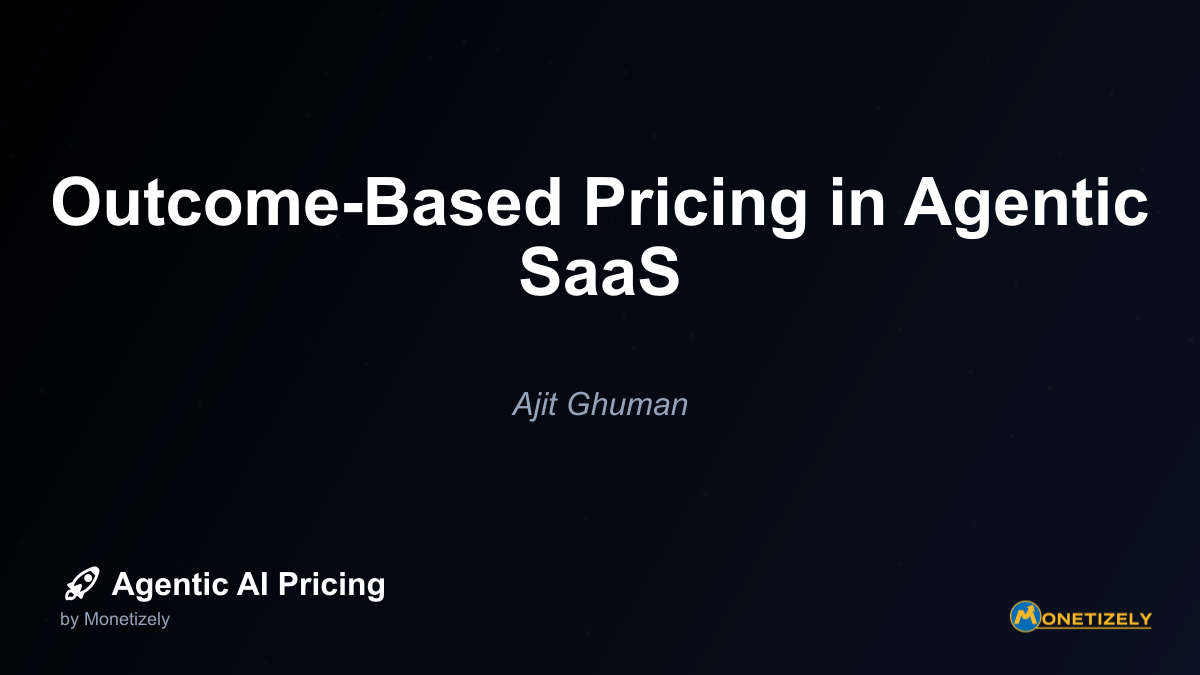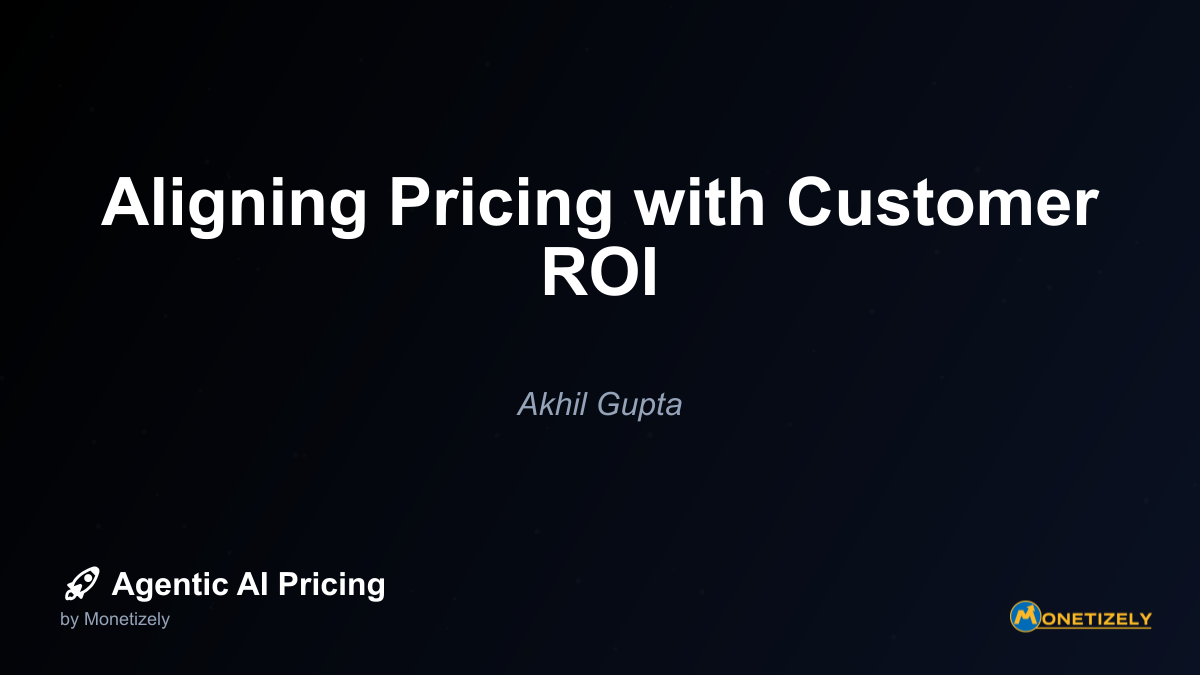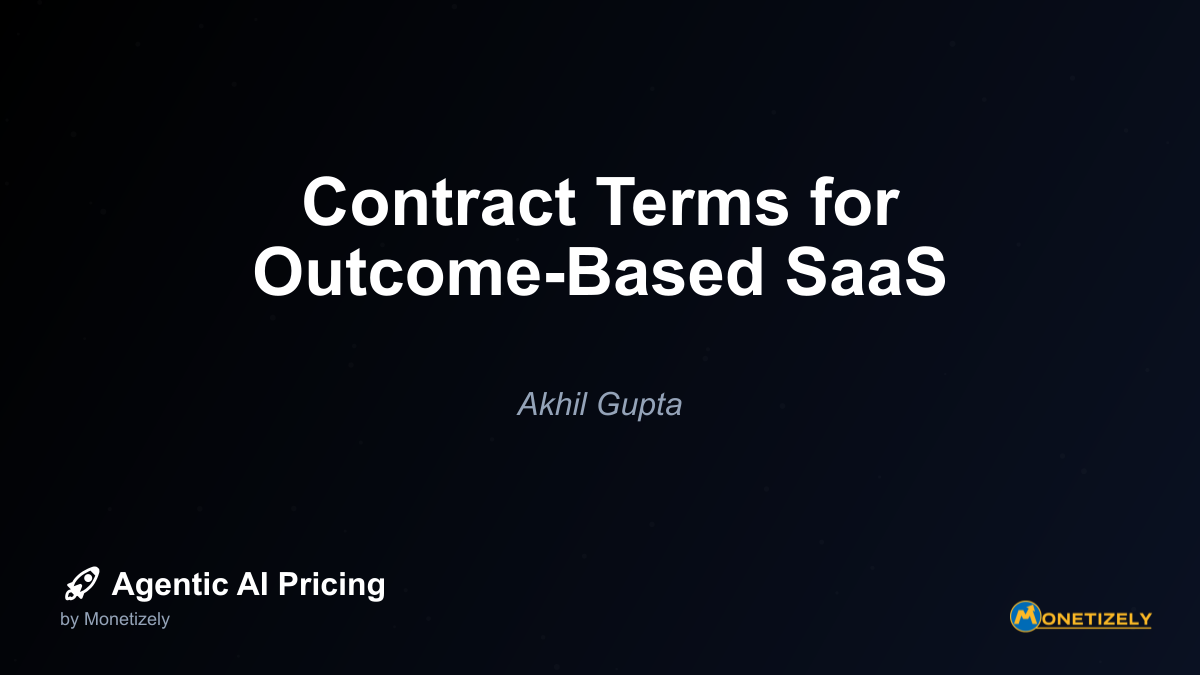· Ajit Ghuman · Pricing Agentic SaaS Products · 12 min read
Outcome-Based Pricing in Agentic SaaS
AI and SaaS Pricing Masterclass
Learn the art of strategic pricing directly from industry experts. Our comprehensive course provides frameworks and methodologies for optimizing your pricing strategy in the evolving AI landscape. Earn a professional certification that can be imported directly to your LinkedIn profile.

In today’s rapidly evolving business landscape, traditional subscription-based pricing models are increasingly giving way to more innovative approaches that better align vendor incentives with customer success. Among these emerging models, outcome-based pricing stands out as particularly well-suited for the new generation of autonomous AI systems. For companies deploying agentic SaaS solutions, where AI agents can perform complex tasks independently, linking payment directly to measurable results represents both a significant opportunity and a complex challenge.
The Evolution of SaaS Pricing Models
The SaaS industry has witnessed several evolutionary stages in pricing strategy. Initially dominated by simple seat-based licensing, the market gradually shifted toward usage-based models that charged for consumption rather than access. However, these approaches still failed to directly connect payment with the actual value delivered to customers.
Outcome-based pricing represents the next logical step in this evolution—a model where customers pay based on measurable business results achieved through the software, rather than how much they use it or how many employees have access.
According to research from OpenView Partners, SaaS companies adopting value-based pricing (which includes outcome-based models) achieve approximately 25% higher net revenue retention compared to those using traditional subscription-only approaches. This statistic alone highlights the potential financial benefits of aligning pricing with customer success.
What Is Outcome-Based Pricing in Agentic SaaS?
Outcome-based pricing in agentic SaaS involves structuring payment models around specific, measurable business outcomes delivered by autonomous AI agents. Unlike traditional pricing models that charge for licenses, seats, or usage, outcome-based pricing directly ties costs to the value created.
For example, instead of charging a monthly subscription for an AI customer service agent, companies might charge only for successfully resolved customer inquiries. Or rather than billing for access to an AI-powered sales assistant, vendors might take a percentage of the additional revenue generated through the system’s recommendations.
This approach fundamentally changes the relationship between vendor and customer, transforming it from a transactional exchange to a strategic partnership where both parties share risk and reward.
Key Components of Outcome-Based Pricing
- Clearly defined outcomes: Specific, measurable results that both parties agree represent success
- Measurement methodology: Agreed-upon systems for tracking and validating outcomes
- Pricing structure: How payments are calculated based on achieved outcomes
- Risk allocation: How financial risk is shared between vendor and customer
- Governance framework: Processes for resolving disputes and adjusting expectations
The Business Case for Outcome-Based Pricing in Agentic SaaS
The shift toward outcome-based pricing isn’t merely a pricing innovation—it represents a fundamental realignment of business incentives in the age of autonomous AI systems.
Benefits for Customers
Reduced implementation risk: Customers only pay for demonstrable value, reducing the risk of investing in solutions that don’t deliver.
Better ROI clarity: By directly connecting payment to specific business outcomes, customers gain unprecedented clarity on return on investment.
Vendor accountability: Outcome-based pricing creates strong incentives for vendors to ensure their solutions deliver real business impact.
Budget justification: When payments are directly tied to measurable outcomes, it becomes easier to justify technology investments to financial stakeholders.
According to a BCG report on B2B software pricing, customers increasingly demand pricing models that align with their business objectives, with 72% of enterprise buyers preferring vendors who can demonstrate clear ROI and value attribution.
Benefits for Vendors
Higher revenue potential: Successful implementations can generate significantly higher revenue compared to fixed subscription models, as payments scale with delivered value.
Competitive differentiation: Offering outcome-based pricing can differentiate vendors in crowded markets by demonstrating confidence in their solution’s effectiveness.
Stronger customer relationships: Sharing in both risk and success creates deeper strategic partnerships rather than transactional relationships.
Continuous improvement incentives: When revenue is directly tied to outcomes, vendors have powerful incentives to continually improve their solutions.
Premium pricing justification: Demonstrating concrete value creation makes it easier to justify premium pricing compared to competitors.
A study by McKinsey indicates that companies using success-based AI pricing achieve positive ROI 40% faster than those using traditional models, highlighting the potential for accelerated value realization.
Real-World Examples of Outcome-Based Pricing in Agentic SaaS
Several pioneering companies have already implemented outcome-based pricing models for their agentic AI solutions, providing valuable case studies for the industry.
Customer Service AI
Zendesk has transitioned to outcome-based pricing for its AI agents, charging customers based on the resolution and quality of AI-driven support interactions. This represents a significant shift away from traditional seat or usage fees.
Intercom charges approximately $0.99 per resolved AI-driven customer support case, directly aligning pricing with meaningful outcomes rather than access or usage.
Sierra.ai offers AI agents with pricing based on outcome complexity, charging only for cases resolved by AI without human escalation. This creates a strong incentive to continuously improve the AI’s capabilities.
Sales and Marketing AI
InsideSales.com (now XANT) implemented “performance pricing” tied to sales metrics like conversion rates and deal velocity, allowing customers to pay based on actual sales improvements rather than just software access.
Financial Services AI
Chargeflow uses AI to automatically dispute chargebacks and charges customers only on successfully recovered funds, creating perfect alignment between the vendor’s revenue and the customer’s financial benefit.
Manufacturing AI
A manufacturing company implemented an agentic AI system for quality control with a pricing model linked to defect reduction. The vendor received 118% of the normal implementation fee due to exceeding performance targets, reducing quality defects by 62% in six months.
Healthcare AI
Veradigm (formerly Allscripts) has moved toward outcome-based pricing with tiered pricing tailored to multiple stakeholders (clinical, financial, IT), emphasizing ROI calculators that demonstrate reimbursement improvement and workflow impacts.
Implementation Methodologies for Outcome-Based Pricing
Successfully implementing outcome-based pricing requires careful planning and execution. Here’s a structured approach based on industry best practices:
1. Outcome Definition and Measurement
The foundation of any outcome-based pricing model is clearly defining what constitutes success and how it will be measured. This process typically involves:
- Identifying key business outcomes that the agentic AI solution can directly influence
- Establishing baseline metrics to measure improvement
- Defining measurement methodologies that both parties agree are fair and accurate
- Creating data access protocols for transparent reporting
For example, a customer service AI might track metrics such as:
- Number of successfully resolved inquiries
- Average resolution time
- Customer satisfaction scores
- Escalation rates to human agents
2. Pricing Structure Design
Once outcomes are defined, the next step is designing a pricing structure that fairly compensates the vendor while providing value to the customer:
Common Pricing Structures
- Tiered outcome-based pricing: Different payment levels based on achievement thresholds
- Percentage of value created: Vendor receives a share of measurable financial benefits
- Hybrid models: Combining fixed fees with variable outcome-based components
- Success bonuses: Additional payments for exceeding target outcomes
According to research from Sierra.ai, hybrid models combining a base subscription fee (40-60% of total cost) with outcome-based variable components have proven most successful in early implementations, balancing predictability with performance incentives.
3. Risk Management Framework
Outcome-based pricing inherently involves risk-sharing between vendor and customer. A robust risk management framework typically includes:
- Performance guarantees: Minimum outcome thresholds the vendor commits to achieving
- Penalty clauses: Reduced payments or refunds if outcomes fall below agreed minimums
- Force majeure provisions: Addressing external factors outside either party’s control
- Dispute resolution processes: Clear procedures for handling disagreements about outcome measurement
A major financial institution implemented an agentic AI fraud detection system with tiered payments based on fraud prevention success and penalties for false positives, achieving 3.4x ROI while providing the vendor with a 28% premium over standard pricing.
4. Implementation and Optimization
The final step involves deploying the solution and continuously optimizing both the AI system and the pricing model:
- Pilot programs: Starting with limited-scope implementations to validate outcomes
- Regular performance reviews: Assessing outcome achievement and making adjustments
- Continuous improvement processes: Enhancing the AI system to improve outcomes
- Pricing model refinement: Adjusting the pricing structure based on real-world performance
Technical Challenges in Implementing Outcome-Based Pricing
While outcome-based pricing offers significant benefits, it also presents unique technical challenges, particularly for agentic AI systems:
1. Outcome Attribution
One of the most significant challenges is accurately attributing outcomes to the AI system versus other factors. For example, if sales increase after implementing an AI sales assistant, how much of that increase is due to the AI versus other market factors or sales team improvements?
Solutions to this challenge include:
- Control group comparisons: Measuring outcomes against similar scenarios without the AI
- Multivariate analysis: Statistical methods to isolate the AI’s contribution
- Progressive implementation: Phased rollouts to establish clear before-and-after comparisons
- Transparent attribution models: Clearly documented methodologies for determining causality
2. Data Collection and Validation
Outcome-based pricing requires robust data collection and validation systems to ensure accurate measurement:
- Data integration challenges: Connecting the AI system with existing business systems
- Data quality issues: Ensuring the accuracy and completeness of measurement data
- Real-time monitoring requirements: Tracking outcomes as they occur
- Audit capabilities: Providing transparent verification of reported outcomes
According to a study by BCG, over 35% of outcome-based pricing implementations face significant challenges related to data integration and quality, highlighting the importance of addressing these issues early.
3. AI Performance Variability
Agentic AI systems may perform differently across various contexts and over time:
- Performance consistency: Ensuring reliable outcomes across different scenarios
- Learning curve effects: Accounting for AI improvement over time
- Edge cases: Handling unusual situations that may affect outcome measurement
- Continuous training requirements: Maintaining optimal AI performance
4. Technical Integration
Implementing outcome-based pricing often requires deep technical integration:
- API development: Creating interfaces for outcome reporting
- Security considerations: Protecting sensitive business data used for measurement
- Scalability challenges: Ensuring measurement systems can handle growing volume
- Legacy system compatibility: Working with existing business infrastructure
Contractual and Legal Considerations
The legal framework supporting outcome-based pricing requires careful consideration:
1. Outcome Definition and Measurement Clauses
Contracts must precisely define:
- What constitutes a successful outcome
- How outcomes will be measured and verified
- The frequency and method of reporting
- Who has access to measurement data and systems
2. Payment Terms and Conditions
Clear payment structures including:
- Base fees versus variable components
- Payment timing and frequency
- Calculation methodologies for outcome-based payments
- Minimum and maximum payment thresholds
3. Performance Guarantees and Remedies
Addressing performance expectations through:
- Minimum performance guarantees
- Remedies for underperformance
- Bonus structures for exceeding targets
- Force majeure provisions
4. Term and Termination Provisions
Considerations specific to outcome-based contracts:
- Initial term length appropriate for outcome realization
- Early termination provisions and associated penalties
- Renewal terms and conditions
- Data access post-termination
5. Intellectual Property and Data Rights
Critical considerations around:
- Ownership of data generated during outcome measurement
- Usage rights for AI improvement and training
- Confidentiality of business metrics and outcomes
- Data retention and destruction policies
Industry-Specific Applications and Challenges
Outcome-based pricing manifests differently across industries, each with unique metrics, examples, and challenges:
Healthcare
Metrics Used:
- Clinical outcome improvements (e.g., reduced hospital readmissions)
- Financial outcomes such as reimbursement optimization
- Efficiency gains (e.g., reduced administrative workload)
Example Companies:
- Veradigm (formerly Allscripts): Uses tiered pricing with ROI calculators showing reimbursement improvement
- Epic Systems: Provides customized ROI analyses based on specific payer mixes
- Phreesia: Deploys structured pilot programs linking pricing to measurable financial outcomes
Unique Challenges:
- Complex multi-stakeholder decision-making with different value perceptions
- Regulatory scrutiny and reimbursement complexity
- Difficulty quantifying clinical outcomes and linking them directly to pricing
Financial Services
Metrics Used:
- Percentage of recovered chargebacks or fraud prevented
- Successful dispute resolutions
- Cost savings from automation of manual tasks
Example Companies:
- Chargeflow: Uses AI for automatic chargeback disputes, charging only on successfully recovered funds
Unique Challenges:
- Outcomes may take time to measure and depend on external factors
- Regulatory compliance complexity
- Balancing transparency with capturing nuanced financial benefits
Manufacturing
Metrics Used:
- Improved equipment uptime
- Increased throughput/productivity
- Reduction in scrap rates or defects
- Energy savings
Unique Challenges:
- Establishing causality between AI interventions and manufacturing KPIs
- Variability in manufacturing environments requiring adaptable outcome definitions
- Integration with legacy systems that may complicate value demonstration
Retail
Metrics Used:
- Increase in conversion rates or sales lift
- Reduction in inventory carrying costs
- Customer retention or repeat purchase rates
Unique Challenges:
- Isolating sales lift caused by AI from other market factors
- Rapid changes in consumer behavior requiring agile outcome definitions
- Short retail seasons creating pressure for quick value demonstration
Customer Service
Metrics Used:
- Number/percentage of successfully resolved support cases
- Reduction in average handling time
- Customer satisfaction or Net Promoter Score improvements
- Cost savings by reducing human agent seats
Example Companies:
- Intercom: Charges per resolved AI-driven customer support case
- Zendesk: Focuses on outcome-based pricing for successful support resolutions
- Sierra.ai: Prices based on outcome complexity, charging only for cases resolved without escalation
Unique Challenges:
- Balancing outcome-based pricing with legacy seat- or usage-based models
- Defining clear, objective criteria for “resolution”
- Accounting for escalated cases or multi-touch issues
Supply Chain
Metrics Used:
- Reduction in logistics/delivery lead time
- Inventory turnover improvement
- Cost reduction in transportation or warehousing
- Compliance improvements (e.g., customs clearance success rates)
Unique Challenges:
- Supply chain variability affecting outcome guarantees
- Multi-party dependencies complicating risk sharing
- Delayed ROI measurement requiring extensive baseline data
Financial Impacts of Outcome-Based Pricing
The shift to outcome-based pricing has significant financial implications for both vendors and customers that must be carefully managed.
Revenue Predictability Challenges for Vendors
Vendors implementing outcome-based pricing face unique revenue forecasting challenges:
Variable revenue streams: Unlike predictable subscription revenue, outcome-based pricing creates variable income based on performance.
Cash flow management: Irregular payment timing may require different cash flow planning compared to subscription models.
Revenue recognition complexity: Accounting for outcome-based revenue can be more complex from a financial reporting perspective.
Investor expectations: Public companies may need to educate investors about changes in revenue patterns and metrics.
According to financial analysis by Growth Unhinged, there has been a decline in pure seat-based pricing across the SaaS industry, indicating a shift toward more innovative models like outcome-based pricing, despite these challenges.
Financial Benefits for Customers
From the customer perspective, outcome-based pricing offers several financial advantages:
Reduced upfront investment: Many outcome-based models require lower initial payments, shifting costs to when value is realized.
Better budget alignment: Costs directly tied to outcomes makes budget justification clearer.
Improved ROI certainty: By definition, outcome-based pricing ensures payment is linked to value received.
Reduced technology risk: If the solution doesn’t deliver, the customer doesn’t pay full price.
Risk Management Strategies
To manage the financial risks associated with outcome-based pricing, companies are implementing several strategies:
Hybrid pricing models: Combining base fees with outcome-based components to provide revenue stability while maintaining outcome alignment.
Outcome guarantees: Setting minimum performance levels with financial remedies if not achieved.
Phased implementation: Starting with pilot programs to validate outcomes before full-scale deployment.
Risk-adjusted pricing: Building risk premiums into pricing to account for outcome uncertainty.
Portfolio balancing: Vendors maintaining a mix of traditional and outcome-based contracts to manage overall revenue risk.
Transitioning from Traditional to Outcome-Based Pricing
For companies considering a shift to outcome-based pricing, a phased transition approach is often most effective:
1. Assessment and Preparation
- Value metric identification: Determining which outcomes most directly reflect customer value
- Measurement capability evaluation: Assessing technical ability to track and report outcomes
- Customer segment analysis: Identifying which customers are most suitable for outcome-based pricing
- Financial modeling: Projecting revenue impacts under various outcome scenarios
2. Pilot Program Implementation
- Select pilot customers: Choose customers who understand the model and are willing to collaborate
- Design pilot pricing structure: Create a limited-scope model to test the approach
- Establish baseline metrics: Measure current performance to enable outcome comparison
- Define success criteria: Determine what would constitute a successful pilot
3. Scaling and Optimization
- **
Co-Founder & CEO
Ajit is the author of Price To Scale, a top book on SaaS Pricing and is the Founder of Monetizely. Ajit has led and worked in pricing and product marketing at firms like Twilio, Narvar and Medallia. His work has been featured in Forbes and VentureBeat. Ajit regularly consults with software companies from Seed stage to post-IPO on pricing strategy. Ajit is also a highly-rated co-instructor for 'The Art of SaaS Pricing and Monetization' on Maven.
Pricing Strategy Audit
Let our experts analyze your current pricing strategy and identify opportunities for improvement. Our data-driven assessment will help you unlock untapped revenue potential and optimize your AI pricing approach.




